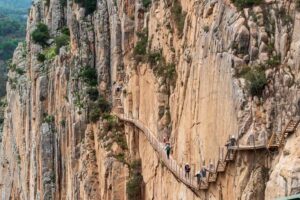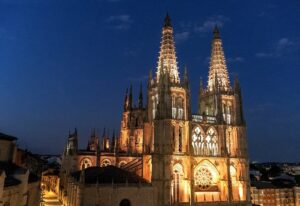Ready to undertake the mystical Camino de Santiago? Before taking the first step, it is crucial to know how do it safely. As you know, this pilgrimage route is food for the soul, but certain precautions must be taken for a more comforting experience.
In this guide, we will reveal essential keys for proper planning, care on the road, and advice on health and well-being. Don’t let unforeseen events spoil your experience! Join us in this guide and ensure an unforgettable journey.
Índice de contenidos
Proper planning: The basis of a safe trip

This is an adventure that captivates thousands every year. However, for this experience to become an indelible memory, it is essential to make a meticulous planning.
The first task is investigate the different routes available, since each one has unique characteristics. For example, the Camino Francés offers a rich mix of culture and history, while the Camino del Norte captivates with its coastal landscapes.
Once you have this idea clear, it is time to set an itinerary. This not only involves deciding the start and end points, but also, the places where you will rest, the daily stages and the places of interest that you cannot miss.
In addition, the dates of your trip They are crucial. And you can’t ignore the weather conditions and the seasons. Each season of the year provides a different nuance to the Camino:
- Winter, with its stillness and snowy landscapes, can be magical, but also challenging due to the cold and certain impassable sections.
- Spring blooms with a spectacle of colors, although you may face occasional showers.
- Summer, hot and bustling, requires sun protection and good hydration.
- Autumn, with its golden hues, is ideal for those seeking serenity, always keeping in mind that the days begin to get shorter.
Essential preparations before the trip

Similarly, previous preparations they play a primary role. Imagine your day as a blank canvas, and your preparations as the brushes and colors that will bring that masterpiece to life.
We start with the . This must be adequate to face the challenges of the road. The right choice can make the difference between a comfortable experience and one riddled with inconvenience.
With regard to the clothing and footwear, it is vital to choose breathable and light materials, which allow freedom of movement and minimize fatigue. The footwear should be comfortable, of quality and, preferably, already “molded” to your feet to prevent blisters and injuries. Don’t underestimate the value of some good socks, ideal for reducing friction.
Also, depending on the season, wear a waterproof jacket may be essential.
La backpack it must be the sspacious enough for your belongings, but not so big that it overloads you. Inside, in addition to clothing and personal items, it is advisable to carry a basic first aid kit, sunscreen, water, and energy snacks. Weight distribution is key: place the heaviest items in the center and close to your back.
In terms of health, it is essential to consider vaccines and medications. It is advisable to be up to date with basic vaccinations and consult a doctor about any medications or supplements that may be useful to you. Additionally, bringing pain medications, anti-inflammatories, and first aid supplies can be of great help.
Accommodation and rest: keys to recovery

El accommodation takes on vital importance, not only as a refuge, but also as a space of interaction and reflection with other pilgrims. First of all, when talking about hostels and hostels, it is essential to do your research and choose those with good references. These places must not only provide a roof, but guarantee hygiene, safety and a friendly environment.
A recommended practice is to do advance reservations. Although the adventurous spirit may lead you to improvise, booking in advance has its advantages, especially in high season. It ensures you a place to rest, avoids the stress of looking for accommodation at the end of the day and, sometimes, allows you access more competitive prices or discounts.
It is always advisable to resort to a travel agency for the Camino de Santiago de Compostela. Support like this is responsible for making everything easier for you so that you as a pilgrim only have to worry about enjoying the experience.
On the other hand, it cannot be underestimated the importance of a good rest in the path. Choosing accommodation that guarantees optimal sleeping conditions – an adequate mattress, a quiet and dark environment, among others – is crucial.
Remember, rest also means listen to your body during the day: If you feel like you need to take a break, find a quiet place, stretch, hydrate, and take a breather.
Health and well-being on the Camino

Of course, for this journey to be rewarding and not become an insurmountable challenge, it is vital to pay attention to the Health and Wellness. We are not only talking about avoiding injuries, but also about take care of yourself in a broad and holistic sense.
One of the most common problems, and one that many pilgrims underestimate, is the blisters. These discomforts can become real torments if they are not prevented or treated in time. Wearing appropriate footwear along with socks made of breathable materials is essential. If you feel a chafing area, act quickly by applying specific dressings or tapes to reduce friction.
Furthermore, the hydration and nutrition They are fundamental pillars. Walking for long hours requires a constant intake of energy and fluids. Drink water regularly, even if you don’t feel thirsty, and supplement with isotonic drinks if the heat is intense.
Regarding nutrition, opt for balanced meals that combine healthy carbohydrates, proteins and fats. Bringing energy snacks, such as nuts or cereal bars, will help you maintain energy levels between meals.
It is vital to listen to your body and recognize the signs of exhaustion. If you feel fatigue, severe muscle pain, dizziness, or any other unusual symptoms, it’s time to take a break. And we’re not just talking about daily breaks, but also considering, if necessary, taking a full day of recovery.
If you consider that you do not have adequate preparation, you can always do the French road from Sarria to Santiago de Compostela organized. It is the minimum distance to travel to be awarded the Compostela and you will also take home an experience like no other.
Safety on the road

Whether you decide to walk alone or in a group, there are certain precautions that you should take into account to guarantee a smooth and smooth trip.
For those who choose walk alone, the experience can be incredibly rewarding, but it is essential to remain alert and aware of your surroundings. Inform always tell someone about your itinerary of the day and keep in touch regularly.
On the other hand, if you decide walk in group, make sure to set meeting points in case of separation and respects the rhythm of each member.
Unforeseen situations or emergencies can arise at any time. Take with you a small first aid kit, know the location of the nearest medical centers and memorize or write down local emergency numbers. Also, if you have a medical condition, inform your fellow travelers or carry identification with you.
In case of disorientation, always follow official signs and, if necessary, do not hesitate to ask other pilgrims or locals for help. Technology can also be your ally: consider bringing a phone with a good battery and specialized apps for the Camino.
Additionally, it is advisable to make copies of your documents and keep them in separate places from the originals.
All these security measures are completely reduced if you have the support of Viajes Mundiplus in the organization, management and advice of the same.
Connection and communication during the trip

There are several Apps designed specifically for pilgrims. They offer detailed maps, shelter locations, and points of interest along the route. In addition, many of these apps allow information to be downloaded to be consulted offline, a valuable resource in areas with low coverage.
Although this is an opportunity to disconnect, keep in contact with family and friends can be comforting and provide a sense of security. Instant messaging apps are essential. Not only to send updates and photos, but also in case of emergency.
Of course, it is vital to remember to carry a Portable Charger and, if possible, a multiple adapter, as power outlets may be limited in many hostels. Furthermore, it is crucial to be aware of the coverage areas. Although most urban areas on the route have good coverage, there are more isolated stretches
Along the Camino, you will also find information points strategically located. These places not only offer brochures and maps, but, in many cases, they have trained staff to answer questions, offer recommendations or help you in case of problems.
Respect and coexistence: shared responsibility
The Camino de Santiago, beyond being a physical journey, is a journey of connection and mutual understanding between pilgrims, locals and the natural environment.
There are certain unwritten rules that every pilgrim should know and follow, not because they are imposed, but because they are born from common sense and the desire to maintain harmony on the path. One of the most significant is the greeting: a simple “Buen Camino” that is shared among pilgrims, generating a sense of community and brotherhood.
Respect the environment It is another fundamental aspect. Nature is a silent but powerful companion on the path. Leaving no trace, not contaminating water sources, and following marked trails are practices that contribute to the conservation of these landscapes, allowing future generations of pilgrims to also enjoy them.
Likewise, it is crucial to be aware of the impact that pilgrims can have on local communities. Respect the locals It involves not only following the rules of each hostel or establishment, but also understanding and valuing the traditions and customs of each place. These are the guardians of the Camino, and their welcome and hospitality make the experience even more enriching.
Finally, travel with an open mind and a positive attitude is, without a doubt, the most important unwritten rule. The Camino is a melting pot of cultures, where people of different origins, beliefs and experiences intersect. Listening, sharing, and learning from others with empathy and without prejudice transforms the trip into a unique and enriching experience.









